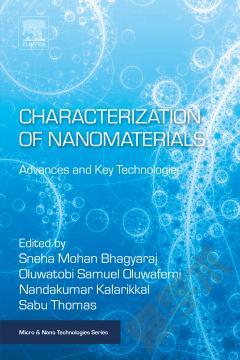Luminescence —— The Instrumental Key to the Future of Nanotechnology
----- 发光学:纳米技术未来发展的关键工具
Preface Important Spectral and Polarized Properties of Semiconducting SWNT Photoluminescence Shigeo Maruyama and Yuhei Miyauchi Important Spectral Features Phonon Sideband in Absorption Various Sidebands in Emission Cross-Polarized Absorption Transverse Quasi-Dark Excitons Advanced Aspects of Photoluminescence Instrumentation for Carbon Nanotubes Said Kazaoui, Y. Futami, Konstantin Iakoubovskii, and Nobutsugu Minami Introduction CNT Thin-Film Fabrication Methods NIR-PL-Mapping Instruments Outlook Developments in Catalytic Methodology for (n,m) Selective Synthesis of SWNTs Yuan Chen, Bo Wang, Yanhui Yang, and Qiang Wang Introduction Effective Catalysts for (n,m) Selective Synthesis Growth Parameters Influencing (n,m) Selectivity Fundamental Understanding of (n,m) Selectivity Characterization Methodology for (n,m) Abundance Evaluation Conclusions and Outlook Single-Walled Carbon Nanotube Thin-Film Electronics Husnu Emrah Unalan and Manish Chhowalla Introduction Purification and Dispersion of SWNTs Thin-Film Deposition Processes Optoelectronic Properties of SWNTs SWNT Functionalization Treatments Applications and Devices Conclusions and Outlook Single-Walled Carbon Nanotube-Based Solution-Processed Organic Optoelectronic Devices Ming Shao and Bin Hu Introduction Effects of SWCNTs on the Electroluminescent Performance of Organic Light-Emitting Diodes CNT Effect on Photovoltaic Response in Conjugated Polymers Exciton Energy Transfer in Carbon Nanotubes Probed by Photoluminescence Ping Heng Tan, Tawfique Hasan, Francesco Bonaccorso, and Andrea C. Ferrari Introduction The Photoluminescence Spectrum of Nanotube Bundles Mechanism and Efficiency of EET in Nanotube Bundles How to Distinguish EET-Induced Features from Other Sidebands in the PL Spectrum? Relaxation Pathways of Excitons in Nanotube Bundles How to Detect Bundles and Probe Their Concentration? Exploiting EET for Photonic and Optoelectronic Applications Conclusions Advances in Dispersal Agents and Methodology for SWNT Analysis Tsuyohiko Fujigaya and Naotoshi Nakashima Introduction Characterization of Dispersion States Solubilization by Dispersal Agents Nanotube/Polymer Composites Summary Time Domain Luminescence Instrumentation Graham Hungerford, Kulwinder Sagoo, and David McLoskey Introduction Overview Light Sources Detectors Data Acquisition Electronics Time-Resolved Measurement System Considerations Summary Key Approaches to Linking Nanoparticle Metrology and Photoluminescence Yu Chen, Jan Karolin, and David J. S. Birch Introduction Fluorescence Anisotropy Theory Experimental Results and Discussions Conclusions Nanometer-Scale Measurements Using FRET and FLIM Microscopy Margarida Barroso, Yuansheng Sun, Horst Wallrabe, and Ammasi Periasamy Introduction FRET Microscopy Choosing FRET Pairs Organic Dye Donor-Acceptor FRET Pair: AF488-AF555 FP Donor-Acceptor FRET Pair: mTFP-mKO2 QD-Organic Dye FRET Pairs: QD566-AF568 and QD580-AF594 Conclusions and Outlook Cancer Detection and Biosensing Applications with Quantum Dots Ken-Tye Yong Introduction Preparation of Quantum Dots with the Hot Colloidal Synthesis Method Types of Quantum Dots Available for Biomedical and Cancer Applications Preparation of Water-Dispersible Quantum Dots Preparation of Bioconjugated Quantum Dots Bioconjugated Quantum Dots and Quantum Rods for in vitro Cancer Imaging and Sensing Multifunctional Quantum Dots and Quantum Rods for in vivo Cancer Targeting and Imaging The Risk and Benefits of Using Functionalized Quantum Dots for Biomedical Health Care Conclusions and Outlook Zinc Oxide Nanoparticles in Biosensing Applications Linda Y. L. Wu Introduction Particle Size Control through Chemical Synthesis and Surface Modifications Bandgap Modification for Visible Emission Bioimaging Using ZnO Nanocrystals Cytotoxicity Tests Conclusions and Outlook Use of QDOT Photoluminescence for Codification and Authentication Purposes Shoude Chang Introduction QDOTs Used as Information Carriers Information Encoding Information Retrieval Applications Conclusions and Outlook Characterization Approaches for Blue and White Phosphorescent OLEDs Brian W. D'Andrade Introduction Blue Electrophosphorescence White Organic Light-Emitting Device Index
{{comment.content}}








 京公网安备 11010802027623号
京公网安备 11010802027623号